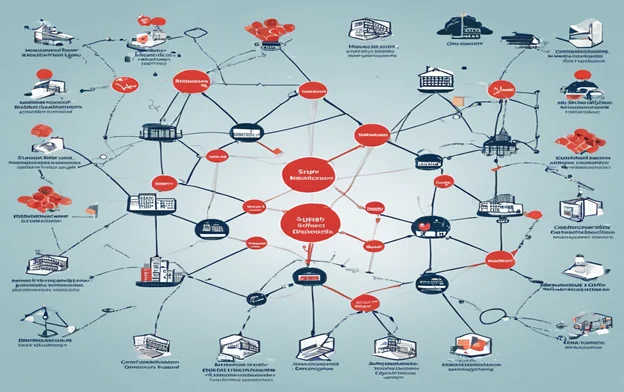Businesses need to adopt unwavering and repetitive activities, approaches, and decision-making practices to mitigate various internal and external challenges. These patterns behavior in business assist such businesses profoundly to circumnavigate the contests, offer abundant opportunities, and facilitate business expansion involving innovation, organizational comparative advantage, operational efficiency, and competency. Therefore, similar patterns of behavior in businesses broaden their range of products, which in turn creates opportunities for increased profitability and a boost in their brand value. As a result, behavior pattern changes are necessary to adjust to variations in business contexts or economic markets.

The pandemic alters the pattern of behavior at the individual and business levels.
In late 2019, the global community recognized the COVID-19 as a pandemic event that profoundly altered people’s perspectives worldwide. It just began with the novel coronavirus SARS-COV-2 and quickly became a worldwide pandemic, intensely affecting the community health, civic services, economies, environment, and routine lives of human beings globally. The occurrence of this COVID-19 swiftly transformed the multilayered effects on ecology, society, economy, business operations, upcoming risks, the healthcare system, cultural revitalization, and social contacts among individuals.
The Pandemic Has Brought About a Revolution in Business
The COVID-19 pandemic affected every segment of the world economy and was considered a catastrophic incident in the recent history of pandemics, claiming millions of lives and leaving a hostile impression on every sector of society and economy. COVID-19 has had a significant impact on business sectors, but many companies adapt very quickly to deal with the novel issues. In addition, this pandemic pressurized the tendencies, forced innovatory behaviors, and evolved enduring conducts with a range of changes that will impact the impending era of such businesses’ flourishment and expansion. As a result, in just a few calendar months, the COVID-19 emergency has brought about a significant revolution in business practices and structural adjustments across all segments and areas involved in conducting such businesses.

Boom in Innovation and Digitalization
One of the crucial changes that occurred during the COVID-19 pandemic and have since revolutionized our customary lives and behavior patterns is the embrace of innovations and digitalization across all sectors of the economy, individuals’ lives, and business priorities. During the COVID time period, physical interactions were restricted due to lockdowns, social distancing measures, restraints on the spreading of the novel Corona virus (COVID) through breathing, exchanges, or sharing of goods, etc. This prevailing situation prompted businesses and their leadership to offer solutions for such problems.

Enlargement in E-commerce Businesses
The concept of online shopping was evolving at its own pace before COVID-19. However, it gets immensely rapid consideration during COVID-19 because of the closure of shopping malls, physical stores, wholesale shops, and constraints on in person shopping from there. Compared to wholesalers or shopping malls, retailers and small shopkeepers have experienced growth during this period. Furthermore, these small shopkeepers and retailers expanded their business by incorporating e-commerce platforms and opening their own online stores to cater to their customers’ demands. Thus, this move encompassed not only the establishment of online stores but also the increased integration of digital payment systems, efficient supply chain management, and customer service facilities to meet the expectations of their customer base.

Walmart and Other Well-Known Businesses Operate Online
Since then, Walmart and other well-known mall brands have expanded their online operations, resulting in a noticeable increase in their sales contribution. Smaller businesses have expanded their online presence by leveraging platforms like “Shopify” to launch and manage their online stores. Therefore, we anticipate that this revolutionary step will leave a lasting impact, as many customers have already chosen to shop online, even as physical stores have reopened. This shift towards online shopping has also led to an increase in demand for fast and reliable delivery services, prompting businesses to optimize their logistics operations. As a result, companies are investing in technology and automation to streamline their supply chain processes and meet the growing expectations of online shoppers.

Virtually Cybernetic Services
Businesses that conventionally depend on face-to-face communication must modernize to achieve a sustainable future. Healthcare service providers have rapidly expanded their telemedicine facilities, allowing patients to look up their relevant doctors virtually. Gyms, exercise courts, and fitness club coaches have turned to online yoga and exercise classes by using platforms like Zoom, Tencent Meeting, Skype, Microsoft Teams, and YouTube to deliver workouts. Educational institutions and universities utilize e-learning tools to maintain connectivity during distance learning.

Surge the Dependence of Cloud Computing
The unanticipated requirement for distant operations and functioning has increased cloud computing’s dependency and acceptability. Companies have invested their monetary funds in cloud computing and its infrastructural development to ensure that their personnel can access essential information and applications on a universal basis. The cloud-created alliance tools, such as Slack, Tencent, Google Workspace, Google Meets, Microsoft Teams, and Zoom, are critical to sustaining efficiency and communication within the personnel teams and working groups.

Distant Modernized Working Structure
Conceivably, one of the most vital and long-lasting deviations has been the prevalent advocacy of distant working and business operations. Earlier in the COVID pandemic, remote working was a mounting but still moderately niche attempt. Since then, however, COVID-19 has forced millions of the workforce to organize work from their homes, leading to a reconsideration of outdated workplace working models.
Home Considered as the Offices and Hybrid Working Models
As an organization transitioned to remote work, it was required to invest in remote work infrastructure. This encompassed furnishing personnel with essential technological resources, including notebooks, monitors, and ergonomic seating. Organizations also implemented secure VPNs to enable remote access to internal networks and protect company data. As the pandemic advanced, an increasing number of organizations implemented hybrid work models, which integrated both in-office and remote work. This model provides employees with the opportunity to exercise flexibility by working remotely at times and attending meetings and collaboration sessions in the office. Tech titans like Facebook and Google have adopted this model, allowing employees to work remotely either permanently or part-time.
Surge in Talent Acquisition
In numerous organizations, remote work has broadened the talent pool. There is no longer a restriction on how companies can hire people in close proximity to their physical locations. Conversely, they are capable of enlisting skilled individuals from any region across the globe, thereby fostering personnel that are more inclusive and diverse. Additionally, this transition has enabled personnel to explore employment prospects without requiring relocation, thereby enhancing job contentment and retention.

Higher Emphasis on Health and Safety including Mental Health
Due to the pandemic, safeguarding the well-being and security of both employees and consumers has emerged as a paramount concern for enterprises. This emphasis resulted in the adoption of numerous health and safety protocols, as well as an increased awareness of employee welfare. Numerous employees have encountered exhaustion, tension, and anxiety as a result of the mental health risks posed by the COVID-19 pandemic. As a result, companies have increased their support for their employees’ mental health. This includes providing wellness programs, counseling services, and resources to assist employees in managing their mental health. Additionally, paid time off for mental health days and flexible work hours have become more prevalent.
Hygiene Protocols and Health Screenings
Organizations implemented more stringent sanitation and cleansing procedures in an effort to mitigate the potential for viral transmission. This included the consistent disinfection of frequently touched surfaces, the provision of hand sanitizers, and the maintenance of clean and sanitary work environments. Offices, retail establishments, and dining establishments have all implemented these safeguards to secure their clients and staff. In numerous workplaces, medical screenings, such as COVID-19 testing and temperature checks, have since become standard procedures. Additionally, some organizations implemented contact-tracing systems to prevent outbreaks and monitor potential exposures.
Supply Chain Resilience and Diversification
The COVID-19 pandemic exposed the vulnerabilities in global supply chains, leading organizations to reevaluate their supply chain strategies to boost resilience and reduce dependence on individual sources. In order to reduce the likelihood of disturbances in the supply chain, businesses have diversified their supplier base. This entails procuring products and materials from a variety of suppliers located in various geographical areas. Businesses can ensure continuity and risk management in the event of future disruptions by avoiding dependence on a single supplier or geographic region. A significant number of businesses have adopted local suppliers to mitigate the risks and complexities associated with international supply chains. Local sourcing has the potential to decrease transportation expenses, improve supply chain dependability, and abbreviate delivery times. Additionally, this transition reduces the carbon footprint associated with long-distance transport and benefits local economies.

Inventory Management and Liquidity Focus
The just-in-time inventory approach, which strives for low stock levels in order to reduce costs, demonstrated its susceptibility during the pandemic due to supply chain disruptions. As a result, numerous enterprises implemented just-in-case inventory strategies, in which they maintained elevated stock levels as a buffer against potential future disruptions. This strategy provides a buffer that enables organizations to continue operations despite disruptions in their supply chains. In order to safeguard cash flow and uphold financial stability, organizations instituted cost-reduction strategies. These measures comprised administrative cost reductions, lease renegotiations, the deferral of non-essential projects, and operational streamlining. Additionally, businesses concentrated on enhancing operational efficiency in an effort to reduce expenses without sacrificing quality. Numerous businesses shifted their focus to preserving liquidity. Therefore, enterprises that effectively managed their liquidity were more ideally positioned to endure the turmoil and expedite their recovery.

Customer Engagement in the Digital Age
In light of the constraints on in-person interactions, enterprises resorted to digital platforms as a means to interact with and cater to their clientele. Amidst this transition, inventive strategies were necessary to sustain customer allegiance and contentment. In order to satisfy the demands of their clientele, organizations implemented omni-channel approaches that merged tangible and virtual interactions. To illustrate, retailers implemented measures such as curbside delivery and purchase online and pick-up in-store (BOPIS) to provide patrons with secure and expedient shopping alternatives. While service providers implemented virtual consultations and appointments, restaurants implemented online ordering and delivery services.
Personalized Customer Service and Digital Engagement
The utilization of improved data analytics enabled organizations to provide customized customer experiences. Through customer data analysis, companies could tailor their marketing initiatives, product suggestions, and customer service engagements to specific customers’ preferences and requirements. Personalized communication assists organizations in strengthening customer relationships and increasing customer loyalty. Organizations have utilized digital channels as a means to maintain customer engagement. Email marketing, social media, and virtual events have evolved into indispensable instruments for engagement and communication. Businesses utilized these channels to update consumers, distribute valuable content, and engage in real-time dialogue. By means of virtual events, including webinars and online seminars, organizations were able to expand their consumer base and provide added value.

Rapid Product Development
The pandemic underscored the importance of innovation and adaptability. Companies that could innovate and adapt rapidly were in a better position to overcome the pandemic’s obstacles and exploit new opportunities. In response to the pandemic, businesses innovated quickly in order to develop new products and services that catered to the resulting demands. For instance, automotive companies produced ventilators, distilleries shifted to produce hand sanitizers, and technology companies developed contact-tracing applications. This capacity to respond rapidly to shifting consumer demands assisted businesses in remaining relevant and satisfying their clients’ needs.

In a Nutshell: Behavior patterns
As a result of the COVID-19 pandemic, business behavior patterns have undergone significant transformations. Trends that have significantly altered the business environment include the transition to remote work, the acceleration of digital transformation, the reassessment of supply chains, alterations in consumer behavior, a greater focus on health and safety, increased agility and innovation, financial prudence, and enhanced corporate social responsibility. Behavior patterns encourage businesses to think creatively and adapt to new ways of thinking, ultimately leading to improved performance.
Dr. Abdul Rauf (Foreign Professor)
School of Management Science and Engineering,
Nanjing University of Information Science and Technology, China.
Email: [email protected], [email protected]
You Might Also Like




This is a exciting work to analyse the key trends shaping the post-pandemic business world. It’s great to see how these challenges are also driving innovation and resilience. The shift to remote work has been fascinating. It will be interesting to see how companies balance flexibility with collaboration in the long run.